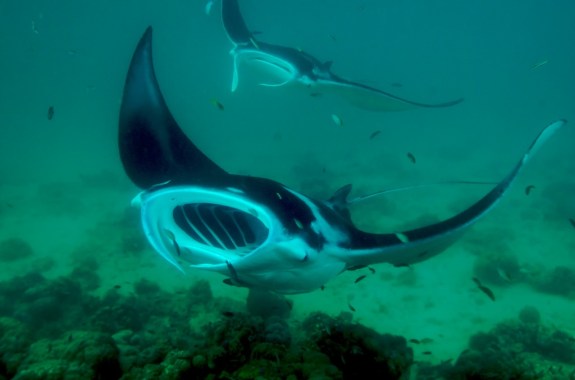Grade Level
6 - 8
minutes
15 min - 1 hr
subject
Life Science
Activity Type:
making models, animal adaptations
Objective: Students will engineer a water filter based on observations of manta ray feeding filters, then test its effectiveness.
Topics: Structure and function, adaptation, engineering and design
People use filters every day to separate solids from liquids or gases. For example, we put filters in our vacuums and coffee makers, in our air conditioners, and in our sink drains. But what most people don’t realize is that some of the world’s most effective filters are actually in the ocean! Many different species of marine organisms capture food by filtering out organic matter and tiny drifting organisms (called plankton) from the water that surrounds them. By observing how the biological filters in these organisms work, scientists can learn how to design better filters for human use.
Watch the Science Friday video “No Strain, No Gain: Filter Feeding Mantas” to learn about the filters that manta rays use to feed.
If you were to create your own marine filter, what would it look like? How would you build it? In this activity, you will engineer a filter and test its effectiveness. To help inspire you, we’ve highlighted some of the filtration structures and mechanisms used by marine filter feeders.
Filtering Structures:
- Pores – holes of varying size that allow water to exit the filter. Only particles smaller than the pore are able to pass through
- Cilia – tiny, flexible hairs that collect small food particles and transport them to a collection area
- Branches – forked structures, like tree branches or feathers, with high surface area that are passed through the water to capture food particles
- Mucous – gooey coating that makes the filter or filter structures sticky, capturing particles it comes into contact with
- Combs – rods with ridged, narrow teeth (just like a hair comb!) that stick out into the flow of water, trapping particles that are too large to fit between the teeth
Filtering Mechanisms:
Materials:
- Filter-making materials*
e.g. plastic bottles, cups, chenille stems, string, tape, paperclips, feathers, ribbon, fabric, plastic wrap - Scissors, tape, binder clips, paper clips
- Testing tank filled with water
a sink, fish tank, bathtub, large bowl, or clean plastic garbage bag works great - Clock or stopwatch for keeping time
- Bag of frozen peas and carrots, thawed (“food particles”) or uncooked rice
- Piece of paper for recording observations and tracking the amount of food caught
Notes:
- Avoid paper products or dyed materials that will get ruined when wet.
- Rather than contributing to a landfill, try to use or reuse stuff you find in the recycling bin. You can also contact a creative reuse center in your community to find low-cost recyclables and re-used materials for the project.
What To Do:
- Think about the size of your “food particles” (peas and carrots), various types of filter-feeding species, and the examples above, and then make your filter!
- Dump the thawed peas and carrots into your testing tank, stir them up, and practice using your filter. After a few runs, return the peas and carrots that you filtered to the tank, and make adjustments to improve your design.
What filter feeding structures seem to be the most useful? How are these similar to the structures on organisms such as manta rays and whales? - Use a clock or stopwatch to see how many peas and carrots you can filter out of the water in 30 seconds. Practice a couple times, then record your best catch rate.
How many could you get? What motions were the most helpful for capturing more?
What To Think About:
- Are there any similarities between biological filters and filters you can find around the house, such as in a vacuum or coffee maker? How could you incorporate biologically inspired filter shapes into your future designs?
- After practicing with your filter, what changes did you make to improve your filter, and why did you make them?
- What would you have to change about your filter to accommodate smaller food particles the size of sand grains?
- How did you change your movement to get the most filtration?
- Watch the following Science Friday video “Blue Whale Barrel Roll.” What clues does it give you for how to move your filter to get the most food? Do you think these tips apply to all filter feeders or just swimming ones?
Next Generation Science Standards:
- NGSS Cross Cutting Concepts: Structure and function
- NGSS Science and Engineering Practices: Developing and using models, constructing explanations and designing solutions
Additional Resources:
- Manta ray monitoring and research – Flower Garden Banks National Marine Sanctuary
- Sponges: Filter-feeding made visible – video from Shape of Life
- Filter-Feeding in Reef Sponges – lesson plan from NOAA National Marine Sanctuaries Education
Featured image of swooping manta rays by Des Paroz/flickr/CC BY-NC-ND 2.0
Meet the Writer
About Ariel Zych
@arieloquentAriel Zych is Science Friday’s director of audience. She is a former teacher and scientist who spends her free time making food, watching arthropods, and being outside.
